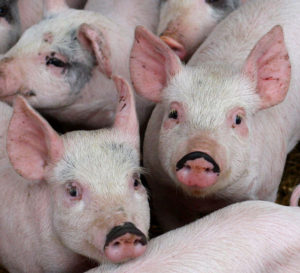
In late September 2019, the U.S. Department of Agriculture finalized rules to deregulate the safety inspection process in pork production and to increase the slaughter of animals, despite the opposition of consumer advocates and several former agency officials.
The new rules allow company employees, rather than USDA inspectors, to determine which parts of meat with defects can be removed from the slaughter process. Companies, instead of USDA inspectors, also will be allowed to determine slaughter speeds, based on their ability to prevent fecal contamination.
The action raises concerns that workers will be incentivized to inspect meat as quickly as possible, increasing the chances that contaminated meat could end up on consumers’ plates, say consumer advocates.
“The implementation of the rule will result in the fox guarding the hen house,” Wenonah Hauter, executive director of the Food & Water Watch advocacy group told Reuters.
Dr. Pat Basu, the USDA’s Food Safety and Inspection Service’s (FSIS) former public health veterinarian added that he believes the new rules could spell “disaster for all … consumers” of pork products, according to Today.com.
In May 2019, the Washington Post dove deep into the controversy about the expected rule changes. The FISIS assistant administrator Phil Bronstein told the paper that the rules give employers more opportunities to fully execute food safety strategies, and that the USDA would still be inspecting producers’ sanitation procedures and would be increasing its checks on animal welfare.
“They are, in a sense, performing part of the inspection process, doing a pre-screening,” Daniel Kovich, director of scent and technology with the National Pork Producers Council, told the Post.
Reporters, of course, should be skeptical, and the development highlights the need for focusing on food safety as part of the health beat. As safe as the U.S. food supply may seem to be, the Centers for Disease Control and Prevention says food safety remains a serious problem.
The public health agency estimates that one in six people in the U.S. get a foodborne illness each year, and 128,000 of them are sick enough to need hospitalization. About 3,000 people die from a foodborne illness each year.
To support journalists in covering foodborne illnesses, recalls and outbreaks, we’ve produced a new AHCJ tip sheet on covering food safety.
And read a “How I Did It” interview that I conducted earlier this year with Sam Bloch, a reporter at the New Food Economy, an online nonprofit publication founded in 2015 that aims to focus attention on stories about the changing food system that the media might be missing.
Take a look at Food Safety News too, it is an online site founded and published by food safety attorney Bill Marler in 2009. The site is chock full of stories about outbreaks and food recalls.






